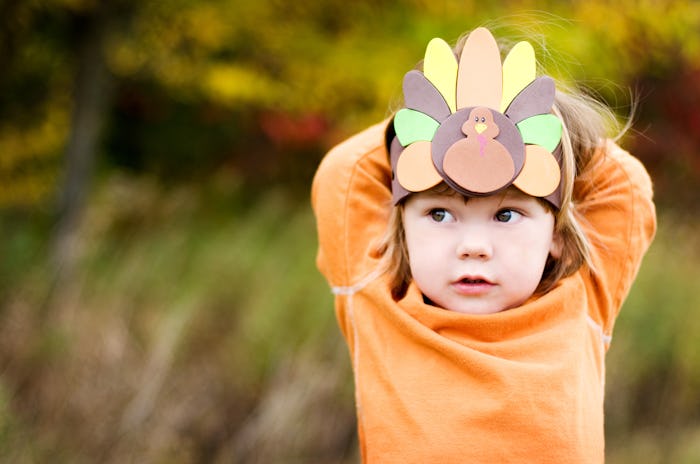The More You Know

20 Fun Facts To Tell Kids On Thanksgiving
Only one of them is inappropriate for the dinner table.
Everyone’s sitting at the Thanksgiving dinner table, silverware in hand, and the devastating news arrives from the kitchen — the turkey needs 30 more minutes. Do you really want to let the kids get up and romp around again, after already wrangling them into their seats? If you need something to fill the time, a list of fun turkey facts to share with kids might do the trick. Because honestly, what kid doesn’t love giggling over learning a little bit of nonsense? Who knows — maybe talking about turkey poop is just the icebreaker your stuffy family members need. This list would be just as fun shared a few tidbits at a time throughout the month to get your children excited about Thanksgiving.
Fun facts about turkeys for kids
Just a heads up — these facts mostly focus on turkeys (the animals) rather than turkey (the food). If your kid is too young to have put two and two together where that’s concerned (and you’d rather today not be the day you have to explain it) just choose which ones to read aloud with caution. With that in mind, enjoy some random bits of turkey trivia, straight from the U.S. Fish and Wildlife Service, the National Turkey Federation, and other authorities on this fine fowl.
- Wild turkeys can actually fly up to 50 mph, but only over short distances. Domesticated turkeys are too heavy to lift off, though.
- On land, they can run up to 18 mph.
- That colorful piece of hanging skin on a male turkey’s head is called a snood.
- Also, adult male turkeys are called toms or gobblers (wonder why). Adolescent ones are called jakes.
- Adult female turkeys are called hens, while the teenagers are referred to as jennies.
- Turkeys have seriously impressive eyesight, usually about three times stronger than a human with 20/20 vision, and a 270-degree view compared to our 180-degree sight.
- Turkeys live to be about 10 years old.
- Turkey poop is very telling. Male turkeys’ poop forms a J shape, while female turkeys’ poop is shaped like a spiral. And the bigger the dump, the older the turkey.
- A fully grown turkey can have up to 6,000 feathers.
- Turkeys are omnivores and like to eat all kinds of things — think seeds, berries, grasses, insects, snails, and even frogs and small reptiles.
- Benjamin Franklin thought the turkey should be America’s national symbol instead of the bald eagle.
- It’s hard to believe now, but in the early 1900s turkeys were on the brink of extinction. Thanks to lots of conservation efforts and funds, there are currently 6.5 million wild turkeys in the U.S.
- A turkey hen can lay 10 to 12 eggs in a single day.
- A wild turkey’s gobble can be heard up to a mile away.
- While we obviously associate turkeys with their signature “gobble gobble” sound, they can also yelp, cluck, hum, purr, cackle, and “kee-kee,” whatever that is.
- Around 46 million turkeys are eaten at Thanksgiving each year.
- The runner-up holidays for most turkeys eaten are Christmas (22 million) and Easter (19 million).
- That many turkeys amounts to about 1.4 billion pounds of food.
- The heaviest turkey ever raised weighed 86 pounds.
- Turkeys can have heart attacks. This was discovered while The U.S. Air Force was doing test runs and breaking the sound barrier, and turkeys at nearby farms began dropping dead.
So, are turkeys your new favorite animal yet? I think we can all appreciate our feathered friends a bit more now.